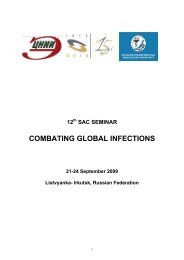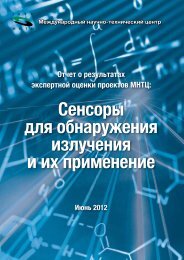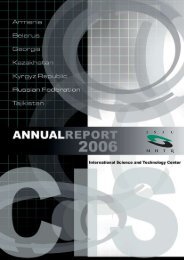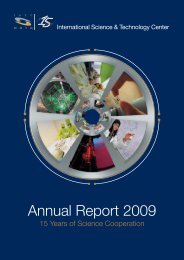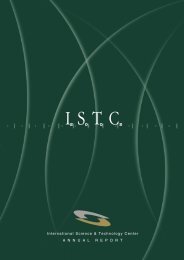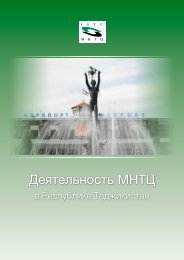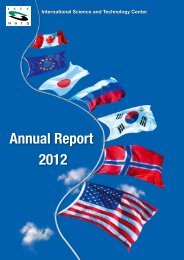Aerospace Research - ISTC Funded Projects 1994-2009
Aerospace Research - ISTC Funded Projects 1994-2009
Aerospace Research - ISTC Funded Projects 1994-2009
Create successful ePaper yourself
Turn your PDF publications into a flip-book with our unique Google optimized e-Paper software.
Project Number: #0548<br />
Enhancement of Flight Performance, Economy and Efficiency<br />
Full and Short Title: Investigations of Technologies, Critical for Implementing an<br />
Airplane of Flying Wing Type with Superhigh Seating Capacity<br />
Flying Wing Airplane<br />
Tech Code/Area/Field: SATAER/Space, Aircraft and Surface Transportation/Aeronautics<br />
Status:<br />
Technology<br />
Project completed<br />
Development Phase: Applied research<br />
Allocated Funding: $695,000 (EU: $347,500, US: $347,500)<br />
Commencement date: (starting date) December 1, 1997<br />
Duration: 36 months, extended by 3 months<br />
Leading Institute: Central Aerohydrodynamic Institute (TsAGI) Zhukovsky,<br />
Moscow reg., Russia<br />
Contact Information: Phone: +7 (495) 5564000, fax: +7 (495) 7776332, 5564337,<br />
website: http://www.tsagi.ru<br />
Supporting Institutes: No<br />
Collaborators: AIRBUS Industrie/ET Engineering Directorate, Blagnac, France<br />
(Hinsinger R); Boeing Company, Long Beach, CA, USA (Liebeck R);<br />
DaimlerChrysler <strong>Aerospace</strong> (Satellites), Friedrichshafen, Germany<br />
(Hormann F); NASA/Lengley <strong>Research</strong> Center, Hampton, VA, USA<br />
(Bushnell D M)<br />
Project Manager: DENISOV Vladimir<br />
Contact Information:<br />
<strong>ISTC</strong> Senior Project<br />
Phone: +7 (495) 5563162, fax: +7 (495) 7776332<br />
Manager: MEYER Uwe<br />
Contact Information: Phone: +7 (495) 9823236, fax: +7 (499) 9780110<br />
<strong>ISTC</strong> Website: http://www.istc.ru<br />
Background<br />
Within recent years, a considerable progress<br />
has been achieved in improving aerodynamic<br />
efficiency of transport airplanes. The main<br />
technique used to improve the lifttodrag<br />
ratio was the development of supercritical<br />
wings, which made it possible to increase<br />
wing thickness and L/D (aspect) ratio. Another<br />
method for increasing the L/D ratio is reduction<br />
of the relative wetted surface S ws , that is,<br />
reduction of the airplane surfaceareatothewingarea<br />
ratio, which can be realized to a<br />
maximum degree in an airplane of flyingwing<br />
configuration with passengers and cargo fully<br />
or partly accommodated in the centerwing<br />
section (Fig. 6). The relative wetted surface in<br />
an airplane of conventional configuration S ws<br />
is 5–6, whereas for the flyingwing<br />
configuration, S ws = 2.3–2.5.<br />
29



